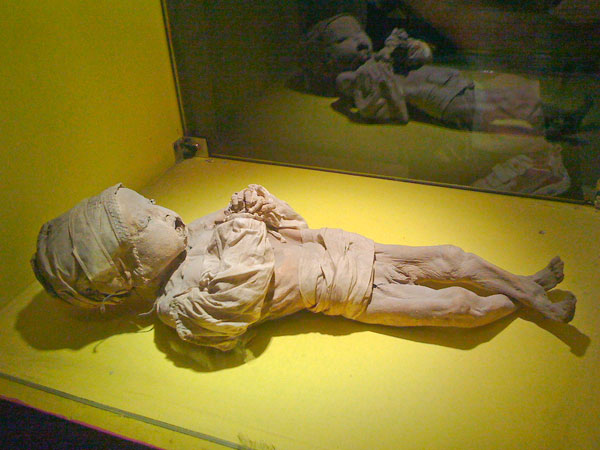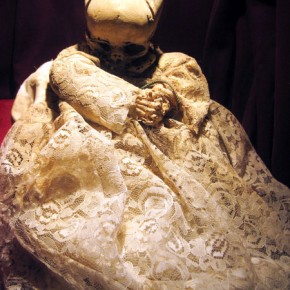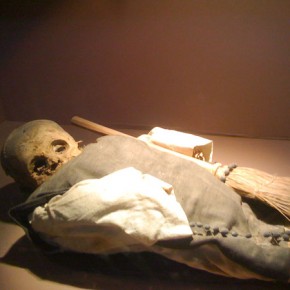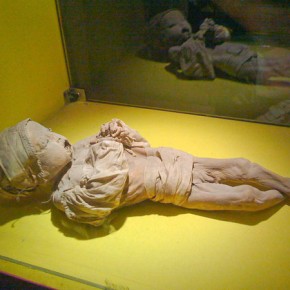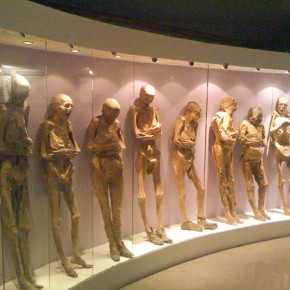ANGELITOS…I’ve heard this word referenced in Spanish songs and poetry lyrics. I always assumed the literal translation ‘little angels’ applied, conjuring pretty images…mostly chubby cherubs or wispy waifs with wings growing out of their backs: a metaphor for lofty sweetness and innocence in humans!
A visit to El Museo de las Momias in Guanajuato straightened me out. You would think the eeriest spectacle in a mummy museum would be a partially decayed body with flesh and musculature still attached imparting all too much humanity to it. You would think.
To the first-time visitor, the display is educational, humbling and at worst, unsettling. A walk through dimly-lit sepulchral corridors certainly makes one think profoundly of death.
The mummies here are not ancient: The first bodies were dug up in 1865. And the reason for this is there is an applicable grave tax and some people were so poor they could not even afford to pay the twenty to fifty pesos a year to keep the bodies buried. Exhumation only ceased after 1958.
The cemetery is subject to soil conditions and a dry climate that work to embalm the bodies. I was told it was the proximity to silver mines and the chemicals used in extraction and refining that helped cause the conditions. A lot of bodies were found fairly intact, some fully dressed. Skin and flesh still cling to bodies in 118 showcases. One figure standing upright in a glass case, boasted as the tallest cadaver, still wears his suit. One poor woman was mistakenly buried alive judging from the position in which she was exhumed. She would never have been buried with her arms protecting her face the way she was found. I saw one cadaver with a lower set of teeth I coveted. There is one pregnant cadaver. One case holds the bodies of a mother and fetus, which is the smallest mummy in the exhibit. There is some controversy as to the ethics of the museum regarding desecration and disrespect. Exhuming is now illegal and at least proceeds from the museum help poor indigenous in the area.
But, here’s the thing. Just before entering the tomb-like corridors housing all these glassed-in bodies, there is a room with sepia and black-and-white photographs. These were families all posing with a young child or baby. The babies in every picture were dressed up like royalty or little saints in confirmation gowns. One portrait was a peasant family of three obviously wearing their best attire. Sometimes it was an older sibling (young children still) holding the baby. Mothers cradled babies.
Some babies wore ribbons, crowns with flowers or bonnets on their heads. Older babies wore little suits. Whatever the clothing it looked to be their church best. Sometimes the babies were sleeping. Sometimes eyes were open. However, I realized the babies were not holding themselves up of their own accord. When I saw a family of four with the baby laid out on a decorative bier, I looked closer at previous portraits. The open eyes of the babies were vacant… lifeless.
Those pictures still haunt me. When I took the time to read the explanation in this small portrait gallery, it turned out these babies had all died either before they had a chance to be baptized or just after, but they never lived long enough to lose their innocence. It is believed that their pure souls go to heaven and they become Little Angels, Angelitos.
Maybe, I, like others will never be compared to an Angel. However, it is comforting that innocent souls may be somewhere floating around in the ether and maybe their purity will lightly brush by us.
- Angelito (Baby Mummy), El Museo de las Momias, Guanajuato. Photo by Adam Coster.
- Angelito (Baby Mummy), El Museo de las Momias, Guanajuato. Photo by Javier Arriola.
- Angelito (Baby Mummy), El Museo de las Momias, Guanajuato. Photos by Javier Arriola.
- El Museo de las Momias, Guanajuato.
- El Museo de las Momias, Guanajuato. Photo by Javier Arriola.

